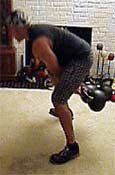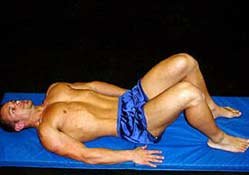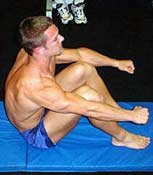| Part 1 | Part 2 | Part 3 |
How do you like your current routine? Is it getting you the results you want? Do you look forward to your time with the iron? Or are you bored and feeling stuck in a rut? Do you need some excitement, a change of pace, some new spark in your training?
Almost everyone has something to say about variety in training. Most people agree that after a while, the body becomes adapted to certain exercises and no longer responds as well as it once did. Variety is a good thing.
The problem is, most of the time a lifter will switch from incline dumbbell presses to Smith machine incline presses or from concentration curls to preacher curls and think he has somehow added variety in to the mix.
Ask any seasoned gym rat what his program consists of and usually you will find the same bunch of exercises done with different set and rep schemes. This is fine if your goal is to become very good at a few different exercises, like powerlifting. But if you want to include variety, don't kid yourself into thinking there is a big difference between dumbbell lateral raises and machine lateral raises, because there isn't.
I want to challenge the way you think about your exercise selection. I want you to start thinking like the old-timers did, when getting strong and fit was the primary concern, and the cosmetic benefits were a welcome by-product.
 Learn How To Perform Over 300 Exercises With Our Exercise Database.
Learn How To Perform Over 300 Exercises With Our Exercise Database.

Exercises For Strength & Conditioning

I have compiled a list of exercises that you may not have ever tried or even heard of. Over the next few installments of this series, I want to share some of my favorites for all-around strength and conditioning.
I encourage you to give them a try and feel the effects they will have on your strength. If you don't like them you can always go back to what you are doing now, right?

Swing:

The first exercise on the list is the swing. This drill will improve your performance in practically any sport. Although I originally learned it as a kettlebell exercise, it can also be performed with a dumbbell. It can be done with both arms simultaneously or with one arm.
It teaches the hip thrust which is essential in many other kettlebell drills as well athletic and martial art applications. The groove of the swing mimics that of the standing vertical jump (SVJ). The difference is that the force of the hip thrust is projected into the weight instead of the body.
Exercise Description:
Straddle a kettlebell or dumbbell. Using your hip flexors "pull" yourself into a squatting position. Push your butt back and look straight ahead. Your back should be straight and your weight should be on your heels. Take hold of the weight and swing it back slightly then forcefully reverse the direction of the swing and drive through with the hips.
Drive the heels into the ground as the weight reaches the top of its arc thrust the hips forward at the top, squeezing the glutes and pulling up the kneecaps. Let the weight swing back between your legs and repeat. Don't attempt to slow the weight down as it swings between the legs, just let it fall and "catch" it with your glutes and hamstrings.
Important Tips:
- Keep your shins as close to vertical as possible.
- Look straight ahead.
- Keep your back straight.
- Contract your abs and your glutes for stability at the top and as the weight swings between your legs.
- Drive your heels into the ground and do not come up on your toes.
- Keep the arms straight, like chains with hooks on the end. Lock the triceps if it helps.

Janda Sit-Up:

Tired of crunches? Good. The Janda sit-up gets its name from its inventor Czech physician Vladimir Janda, one of the world's leading experts on muscle function analysis and back trouble.
Professor Janda devised a way to completely eliminate the hip flexors from the sit-up, thereby putting the full stress on the rectus abdominus. I am normally opposed to the idea of "muscle isolation" because it negatively affects the body's ability to function as a unit. The Janda sit-up is an exception. This deceptively simple looking exercise is one of the most difficult and effective you can do for your abs.
Exercise Description:
The best way to do the Janda sit-up requires a partner. Lie on the floor with the knees bent to ninety degrees and your feet flat. Your partner will hold on to your legs about halfway between your ankles and knees and apply steady pressure as if trying to pull your feet off the floor. Don't let him.
Tighten your glutes and hamstrings to keep your soles flat on the floor. Keep your arms at your sides and slowly sit up without jerking. Squeezing the hamstrings and glutes takes the hip flexors out of the movement due to a neurological phenomenon called Reciprocal Inhibition, which causes a muscles to relax when its antagonist contracts.
In this case, the antagonist muscle groups are the hip flexors (illio-psoas) and the glutes and hamstrings. It is very important to maintain tension throughout the entire rep. Not only will this completely isolate the abdominals, but by removing the hip flexors lower back stress is virtually eliminated.
You probably won't be able to complete even one full-range rep at first, it is that difficult. If this is the case, begin in the top position and perform a slow negative. Completely relax at the bottom and use your arms to get back into the top position for the next rep. eventually you will build up to full range reps.
Important Tips:
- Keep tension on the glutes and hamstrings throughout the entire movement.
- Roll up and back down, one vertebra at a time.
- Keep the reps in the three to five range.
- If full-range reps are too difficult, begin with negative half-reps.
Next time we will look at a couple more drills that will improve your overall strength and get you funny looks from people in the gym.
| Part 1 | Part 2 | Part 3 |





